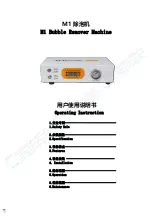
11
MU80 MIDI Data Format
1.2.23.3 All Notes Off
Switches off all of the channel’s’ “on” notes. Any notes being held by HOLD1 or
SOSTENUTO continue to sound until HOLD1/SOSTENUTO goes off.
1.2.23.4 Omni Off
Same processing as for All Notes Off.
1.2.23.5 Omni On
Same processing as for All Notes Off.
1.2.23.6 Mono
Generates “All Sound Off” operation. If the value of the third byte (mono number) is 0 to
16, the channel changes to Mode 4 (m=1).
1.2.23.7 Poly
Generates “All Sound Off” operation, and sets the channel to Mode 3.
1.3
Program Change
If multipart parameter “Rcv PROGRAM CHANGE” is OFF, the part ignores this message.
If “Sound Module Mode = C/M”, drum voice parts ignore all Program Change messages.
1.4
Pitchbend
If multipart parameter “Rcv PITCH BEND” is OFF, the part ignores this message.
1.5
Channel Aftertouch
Not effective under initial settings.
If multipart parameter “Rcv CHANNEL AFTERTOUCH” is Off, the part ignores this
message.
1.6
Polyphonic Channel Aftertouch
Not effective under initial settings.
If multipart parameter “Rcv POLYPHONIC CHANNEL AFTERTOUCH” is Off, the part
ignores this message.
This message is effective only for note numbers 36 through 97 only.
2. System Exclusive Messages
2.1
Parameter Change
The MU80 supports the following Parameter Change messages.
[UNIVERSAL REALTIME MESSAGE ]
1) Master Volume
[UNIVERSAL NON-REALTIME MESSAGE ]
3) General MIDI Mode On
[XG NATIVE ]
1) XG System on
2) XG System Data parameter change
3) System Information
4) Multi Effect1 Data parameter change
5) Multi EQ Data parameter change
6) Multi Effect2 Data parameter change
7) Display Data parameter change
8) Multi Part Data parameter change
9) AD Part Data parameter change
10) Drum Setup Data parameter change
[MU80 NATIVE ]
1) MU80 System Data parameter change
2) Current Performance parameter change
3) Remote switch
[Others]
1) Master tuning
2) TG300 System Data parameter change
3) TG300 Multi Effect Data parameter change
4) TG300 Mutli Part Data parameter change
2.1.2
Universal Realtime Message
2.1.2.1
Master Volume
11110000
F0
= Exclusive status
01111111
7F
= Universal Realtime
01111111
7F
= ID of target device
00000100
04
= Sub-ID #1=Device Control Message
00000001
01
= Sub-ID #2=Master Volume
0sssssss
*SS
= Volume LSB
0ttttttt
TT
= Volume MSB
11110111
F7
= End of Exclusive
or
11110000
F0
= Exclusive status
01111111
7F
= Universal Realtime
0xxxnnnn
XN
= Device Number, xxx = don't care
00000100
04
= Sub-ID #1=Device Control Message
00000001
01
= Sub-ID #2=Master Volume
0sssssss
SS
= Volume LSB
0ttttttt
TT
= Volume MSB
11110111
F7
= End of Exclusive
Received Volume MSB is written to System Parameter MASTER VOLUME.
*Hexadecimal representation of 0sssss ss. (Same below)
2.1.3
Universal Non-Realtime Message
2.1.3.1
General MIDI Mode On
11110000
F0
= Exclusive status
01111110
7E
= Universal Non-Realtime
01111111
7F
= ID of target device
00001001
09
= Sub-ID #1=General MIDI Message
00000001
01
= Sub-ID #2=General MIDI On
11110111
F7
= End of Exclusive
or
11110000
F0
= Exclusive status
01111110
7E
= Universal Non-Realtime
0xxxnnnn
XN
= Device Number, xxx = don't care
00001001
09
= Sub-ID #1=General MIDI Message
00000001
01
= Sub-ID #2=General MIDI On
11110111
F7
= End of Exclusive
This message switches SOUND MODULE MODE to XG.
This message is ignores if operation is in C/M mode.
If “Rcv GM EXCLUSIVE = OFF”, the message is ignored.
This message requires approximately 50ms to execute, so sufficient time should be allowed
before the next message is sent.
2.1.4
XG Native Parameter Change
11110000
F0
Exclusive status
01000011
43
YAMAHA ID
0001nnnn
1n
Device Number
01001100
4C
Model ID
0aaaaaaa
aaaaaaa
Address High
0aaaaaaa
aaaaaaa
Address Mid
0aaaaaaa
aaaaaaa
Address Low
0ddddddd
ddddddd
Data
|
|
11110111
F7
End of Exclusive
Data size must match parameter size (2 or 4 bytes).
2.1.4.1
XG System On
11110000
F0
Exclusive status
01000011
43
YAMAHA ID
0001nnnn
1N
Device Number
01001100
4C
Model ID
0aaaaaaa
00
Address High
0aaaaaaa
00
Address Mid
0aaaaaaa
7E
Address Low
00000000
00
Data
11110111
F7
End of Exclusive
This message switches SOUND MODULE MODE to XG. The message requires
approximately 50ms to execute, so sufficient time should be allowed before the
next message is sent.
2.1.4.2
XG System Data parameter change
See Tables 1-1, 1-2.
2.1.4.3
System Information
System information is sent in response to dump request. Any received parameter changes
are ignored.
See Tables 1-1, 1-3.













































